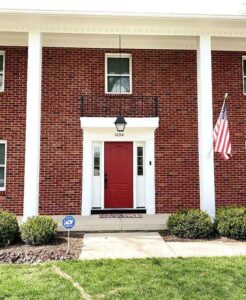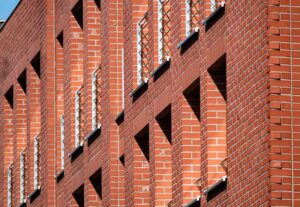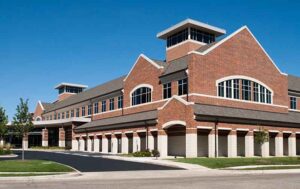Your Brick and Masonry Staining Experts
 Give Your Brick and Masonry a Facelift With Brick Staining
Give Your Brick and Masonry a Facelift With Brick Staining
Brick is one of the most used materials in homebuilding. It’s a go-to choice as an exterior finish and is commonly used on chimneys and fireplaces. Unfortunately, after years of exposure to weather or the extreme temperatures of burning a fire, your brickwork may start to look a little worn – even though it’s technically still in good shape structurally.
If you’re tired of looking at your old brick or you just want to spruce your house up a bit, brick staining could be a great option for your home. Mid-Valley Chimney is a longtime supplier of Masonry Cosmetics’ permanent brick staining products, and we can help reinvigorate your brickwork to give your home a fresh, new look.
What Is Brick Staining or Masonry Staining?
Brick staining is the process of applying color to bricks or masonry surfaces to change their natural appearance. It can be used on both exterior and interior brick surfaces, and it allows the natural texture and character of the bricks to show through, while adding color to brighten it up.
Brick staining can help rejuvenate old or faded brick surfaces, cover up stains or imperfections, and provide a cost-effective alternative to replacing or repainting bricks.
 Is Brick Staining Better Than Painting?
Is Brick Staining Better Than Painting?
If you want to add color to your brickwork, your two primary options are painting and staining. Both options have their benefits, but staining offers more versatility and a smoother appearance when done. The main difference between the two methods is that brick stain is a translucent mineral product that is completely absorbed into the brick, whereas painting requires covering the entire surface of the brick – including the mortar – with a relatively thick layer of paint.
So, which is better? When it comes to your chimney, we’ll also urge our customers to go for staining.
Why is staining the better option?
- Staining doesn’t chip, bubble, or pull away from the brick, so it’s considered permanent.
- Unlike painted brick, stained brick does not allow water to become trapped below the surface.
- Staining materials are vapor-permeable, so any pre-absorbed moisture can still vent out.
- Staining doesn’t alter the texture or overall aesthetic/composition of the brick – it just changes the color.
- Staining doesn’t clog up the pores of your brickwork, which could seal in moisture and cause damage.
What Are the Benefits of Brick/Masonry Staining?
For homeowners looking for a way to update their home’s curb appeal or fix it up before putting it on the market, brick staining is a great choice for a few reasons.
Aesthetics That Fit Your Taste: Staining allows you to change the color of bricks, while still maintaining their natural texture and appearance. In other words, it can transform the look of a building or surface, giving it a fresh and updated appearance, while not inviting any major structural changes or issues. When you work with us, you choose from a wide range of colors to suit your preferences. Or we can customize a color for you to achieve your desired look and match other architectural and design elements of your home.
Brickwork Can Still Shine: The natural look of masonry is one of its most charming features. Paint may cover up surface flaws well, but it also takes away from the physical properties that make brickwork special. By staining, you can add color without taking away character.
Staining Is Affordable & Quick: Rebuilding or replacing brick is costly and time-consuming. If you’d like to change up your home’s look without breaking the bank, brick staining provides a solution that is fast and relatively inexpensive. In addition, brick staining is generally a faster process compared to other brick surface treatments, as it doesn’t require much surface preparation or multiple coats like painting. With proper preparation and application techniques, staining can be completed efficiently, saving time and money on construction or renovation projects.
It Won’t Fade or Chip: Staining seeps into the porous surface of the brick, so the color change will be permanent. Along with this, the color is resistant to fading and does not require frequent touch-ups or reapplication like paint. It can withstand the elements and sustain a fresh appearance over long periods, so you will save money on maintenance and upkeep.
Bricks Can Breath: Bricks and mortar aren’t waterproof and if bricks don’t breathe, they can’t release moisture that becomes trapped under its surface. As you might imagine, this can trigger a lot of damage and deterioration over the years. Unlike some types of paint, staining materials do not seal the brick surface completely and clog up its pores. Long story short – your brick can keep its breathability.
Some Other Things to Consider…
Now, although brick staining is a great option for homeowners, it’s not always the right choice. All renovations and remodels come with concerns and staining is no exception. Here are a few additional things (or potential downsides) to think about when considering staining:
Brick Staining Is Permanent. While also considered a big pro, the fact that the brick staining is a permanent process can also be a downside for those not wanting to fully commit. Once the stain is applied and absorbed into the bricks, it is nearly impossible to remove. The stain is thin enough to embed itself deeply into the pores of the brick. You can remove staining by sandblasting, but a thin layer of brick will be removed in the process.
Brick Staining Takes Some Prep Work. Proper surface preparation is crucial for successful brick staining. The bricks need to be thoroughly cleaned and free of any dirt, debris, or previous coatings for the stain to adhere correctly. Depending on the condition of your brickwork, surface preparation can be time-consuming and require specialized cleaning techniques or equipment. The good news for folks in the Montgomery County area, though, is our techs are equipped to handle any staining project – big or small.
Brick Staining Isn’t Good For All Brick Types. Not all bricks are suitable for staining. No matter how much we customize or coat, we may not be able to get the look you want with certain brick types. If your brickwork has heavy mortar deposits, efflorescence, or excessive damage, your home is not a good candidate for brick staining – at least not until after repairs or corrective measures are taken.
Reach out to Mid-Valley for a consultation before staining your brick. We will evaluate your setup, get a feel for what you’re looking for, and tell you whether or not brick staining is a good or viable option for you.
 How Do I Stain Masonry? Can I DIY?
How Do I Stain Masonry? Can I DIY?
The staining process typically involves cleaning the surface to remove dirt, dust, and any previous coatings. Once the surface is clean and dry, a staining solution or colorant is applied using various techniques such as brushing, spraying, or rolling. If applied correctly, the stain is then absorbed into the porous surface of the bricks, giving your brickwork a permanent color change. Multiple coats may need to be applied to achieve the desired color intensity or to create color variations.
Now, that’s the basic lowdown on the process. The next question we tend to get is… can I DIY?
Brick Staining
This staining process might sound simple, but trust us – you want to hold off on adding brick staining to your weekend DIY agenda.
Staining a home or chimney for the first time is a big project that requires skill and experience. If done incorrectly, you could notice discoloration or inconsistencies, and you could even damage the brickwork in the process. All of this invites more headaches and more cost, especially if corrections then need to be made by a professional.
So, here’s our recommendation: If you haven’t painted or stained brick before, call in a professional to do the job for you. At Mid-Valley Chimney, we have years of experience in brick staining, and we use only the most trusted products from Masonry Cosmetics. Don’t give yourself the stress of worrying about uneven color distribution, streaking, or blotchiness. We will get the work done efficiently, while you use your weekends the way they were intended – to relax by your fireplace.


